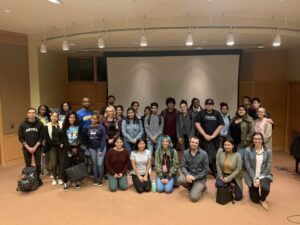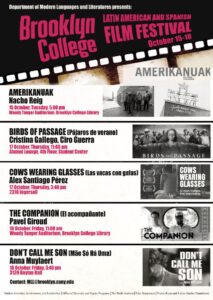by Pedro Cabello del Moral
In our preschool system, children spend the first week of classes talking about their emotions. Teachers make sure young learners feel safe in the space before anything else occurs, so that they can thrive in that environment and build upon their own comfort. The first month of classes is devoted to exercises for community building: learning names, playing together, solving problems collectively, etc. Strong alliances are forged which turn into solid bases for learning pleasurably surrounded by friends. Years pass, and the questions of friendship and community get progressively displaced by the logic of individual competition and the fetishism of the grades. By the time we arrive at college, thin support for the group and thick pressure upon the individual tend to be the default dynamics.
As an international graduate student, I have had mixed experiences in the different public and private universities I attended in Europe and the U.S. Some were marked by the anonymity of being one of the hundreds of students in a crowded classroom, others by the richness of graduate seminars in which participation was meaningfully valued. However, I always felt that instructors could have done more to build community in the classroom as part of a collective project to unthink and undo the stressful competitive dynamics that characterize higher education almost everywhere.
Politics of Friendship
All of these were questions that I had in mind when I started teaching my own courses in the Modern Languages and Literatures Department at Brooklyn College and the Romance Languages Department at Hunter College. Teaching at CUNY provides opportunities to reconnect with the joy of learning collectively and to carry out a true politics of friendship in the classroom.
What do I mean by politics of friendship? It is not that the participants of a course (both professors and students) are necessarily going to hang out together after classes. That happens sometimes, but what I consider more important is that the teaching community practices the kind of horizontal relationships of comradery, mutual trust, respect, and accountability that we encounter in true and lasting friendships. This pedagogical approach, as is the case with most friendships, implies a commitment to celebrate joy and togetherness. As bell hooks remarks, any engaged pedagogy “enables students and professors to feel the joy of learning,” moreover, it “is really the only type of teaching that generates excitement in the classroom.” (1994, 204) As I have confirmed in my experiences at CUNY, a politics of friendship sets up a joyful tone for communal sharing and critical thinking, encouraging, oftentimes, quieter voices to feel more comfortable speaking up.
A politics of friendship evolves from decolonial and abolitionist approaches to education as it compels us to shift from the dominant individualistic/competitive approach toward a we-centered pedagogy. A politics of friendship can alter the physical and emotional spaces of our classrooms and brings up different configurations for collaboration. It affects how we intervene and talk to each other, and ultimately, it has an impact on the way we evaluate our courses.
There is no doubt that this feeling takes time and consistent attention to crystallize, and it does not emerge evenly for all members of the teaching community. Often, students initially react to discussions about friendship in the classroom with some degree of skepticism. . However, they generally recognize the need to subvert traditional classroom power dynamics, and that recognition forms the starting point to embark on this project. We do not need to set extremely high expectations of fully achieving a goal. Rather, a politics of friendship might instead be conceived as a horizon of possibilities or field of experimentation.
Some Strategies to Build Community
One of the first things I try to do in my classes is to change the default spatial setup of the classroom. Before we start the first lesson, I ask students to form a circle with their chairs. This small intervention begins to deconstruct the traditional hierarchy between professor and students and introduce a more horizontal dynamic. As we engage in discussions, I insist on making sure we address each other by our names and pronouns. A politics of friendship requires caring for each other in the space that we share, and that begins with an acknowledgement of each others’ personhood.
In addition to the seating arrangement, the teacher’s podium is another spatial element that connotes a certain privileged access to intellectual resources. In my classes, I attempt to shift this logic by turning the podium, and the professor’s computer, into a shared resource. I invite students to use the professor’s computer to look for images, videos, or comments that they consider relevant and want to share with their peers. I also invite them to stand at the podium when they are giving presentations. As the semester progresses, students begin to feel comfortable moving through the classroom and proposing their own initiatives.
I have learned from my experiences working at CUNY that a teaching community gets more inclusive when it is supported by virtual channels of participation; these might include blog posting, assignments submission, and information sharing. CUNY Academic Commons is a comprehensive tool for expanding classroom conversations and giving students agency. I use this resource even if the course has its own digital learning platform, as is the case with many language courses. I make this choice in order to bring the values of Open Educational Resources into every class. OER fosters a politics of friendship via free access and circulation of information and commentaries. This intellectual commons also becomes an affective archive of our classroom relationships, because the collective memories preserved on these platforms remain available for revisiting, reusing, and remixing at any point by any member of that community—even after the semester ends.
These practices of sharing inform how we approach class materials of all kinds: articles, media, music, grammar exercises, etc. Not only do we shift from a logic of competition to one of collaboration, but we also welcome requests for help and make space for divergent emotions and attitudes toward learning. As instructors, we still likely contend with the fact that some people do not participate, share, nor get involved in the discussions for whatever reason. However, it is also possible to cultivate a sense of ease and learn from those silences just as we do in our friendships.
As we introduce the politics of friendship into our teaching communities, we might invite opportunities for socialization usually deemed unnecessary within the typical competitive logic. One activity I always propose in my classes, regardless of the subject matter or the number of students, is a day in which we sit down together and share a meal. I believe that the act of sharing food—especially when it is food that we cook together—meaningfully shifts classroom dynamics and deepens conversations. For Spanish language classes, I cook dishes from Spain, my country of origin, and also invite the students to bring food from their respective culinary cultures. Around these meals we strengthen our affective ties and build a robust teaching community.
Experimenting with Collective Grading
I have recently started to ask what it would mean to dispense with individual and group-based grading, and instead grade the class effort as a whole. How would we evaluate the teaching community we have fostered throughout the course of the semester? How might we assess our collective commitment to the politics of friendship?
In a course on Latin American and Spanish Film that I taught at Brooklyn College, I partially put this idea into practice. In this course, we organized a film festival. This was a week-long, collective project in which all students participated and were equally responsible for its success. I decided that I was going to reverse the process of grading and think about what we actually needed to achieve an A grade. I identified some components of our collective grade, such as the curation of the sessions, the participation of the speakers, and the ability to convene an audience. Following a discussion about this rubric, we awarded ourselves a collective A for the film festival, and this accounted for 15% of the final grade.
These reflections on the Latin American Film Festival at Brooklyn College lead me to consider some broader principles. We might understand collective grading as:
- A critical approach to assessment.
This means grading the project as a whole rather than the individual labor of each of the participants separately. - A critical approach to labor.
Every student should have a role and, concomitantly, every student should make sure that all the tasks are completed. This leads to a more nuanced notion of accountability that replaces the conversation of who did more work with a shared sense of accomplishment. - A critical approach to property.
In group projects ideas normally flow. Authorship is collective and whatever product comes out is shared as part of the class commons.

Group photo of the participants in the first session of the Brooklyn College Latin American and Spanish Film Festival in the Woody Tanger auditorium at Brooklyn College Library. Via Inaugural screening: Amerikanuak, 2019 Brooklyn College Film Festival.

Brooklyn College Latin American and Spanish Film Festival poster. Via 2019 Brooklyn College Film Festival.
These ideas are still in formation and would benefit from dialogue with other similar approaches to foster community and horizontal participation. Many of the things I tried did not have the outcome that I expected and some of the more successful interventions might not be reproducible in other course contexts. At CUNY, we encounter a very heterogeneous student community, whose responsibilities, and time availability are limited by the fact that many students work multiple jobs. Developing a politics of friendship in the classroom takes time, commitment, and habit. In one of the recent courses I taught, the students who were more involved in building community and bringing joy to our interactions were, unfortunately, the same students who were most frequently absent. Partly because of that, the project of cultivating friendship felt unfinished. My attempt at collective grading in the film festival also faced setbacks. Although the experience was very satisfying, I could see that some students were discouraged to go back to a more traditional form of individualized assessment in their final papers. One student in particular, who contributed great ideas for the festival and came to all the events, decided not to submit the final paper altogether. From this experience, I learned the importance of maintaining a consistent grading philosophy throughout the semester.
Every new class is an opportunity to learn from our mistakes and to take steps towards the horizons we have envisioned. Sharing these attempts to foster comradery, respect, mutual accountability, joy, and togetherness at CUNY is part of the project of education as a key site for unlearning oppression.
———-
Pedro Cabello del Moral is a doctoral candidate in Latin American, Iberian, and Latino Cultures and a TLC Fellow.










Leave a Reply